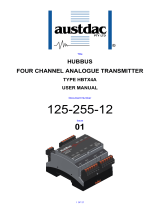1MRS 752263-MUM
Motor protection Relay
Technical Reference Manual
REM 610
5
5.1.2.4. Checking the set safe stall time for a single
start ..................................................................119
5.1.2.5. Restart inhibit level, θ
i
.......................................119
5.1.2.6. Prior alarm level, θ
a
..........................................119
5.1.2.7. Time constant multiplier, K
c
..............................119
5.1.3. Start-up supervision .......................................................119
5.1.3.1. Start-up supervision based on thermal stress
calculation ........................................................119
5.1.3.2. Checking the need for speed switch ................120
5.1.4. Cumulative start-up time counter ...................................120
5.1.5. Short-circuit protection ...................................................121
5.1.6. Unbalance and phase reversal protection .....................121
5.1.6.1. Selecting the start value for stage I
2
> ..............121
5.1.6.2. Selecting the time constant, K
2
........................121
5.1.6.3. Connection with two phase current
transformers .....................................................122
5.1.7. Earth-fault protection ......................................................122
5.1.7.1. Stabilizing virtual earth-fault currents ...............123
5.1.7.2. Increasing the sensitivity of the earth-fault
protection .........................................................123
5.1.8. Circuit-breaker failure protection ....................................123
5.1.9. Temperature protection (optional) ..................................123
5.2. Application examples ................................................................124
5.2.1. Protecting a circuit-breaker controlled motor .................124
5.2.2. Protecting a motor at an ambient temperature other
than 40°C .......................................................................125
5.2.3. Protecting a contactor controlled motor .........................126
5.2.4. Protecting non-rotating objects ......................................127
5.2.5. Earth-fault protection in an isolated or a compensated
network ..........................................................................127
5.2.6. Earth-fault protection in a solidly earthed network .........127
6. Ordering information ............................................................129
7. Revision history of REM 610 ................................................131
7.1. Revision identification ...............................................................131
7.2. Changes and additions to the earlier released revision A .........131
8. References .............................................................................132
9. Abbreviations ........................................................................133
10.Check lists .........................................................................135




















